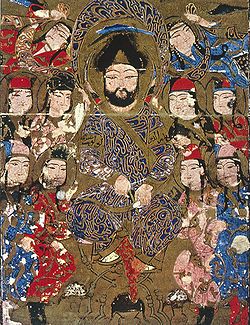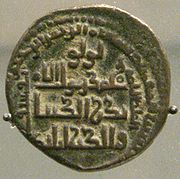
Badr al-Din Lu'lu'
Encyclopedia

Zengid dynasty
The Zengid dynasty was a Muslim dynasty of Turkic origin, which ruled parts of Syria and northern Iraq on behalf of the Seljuk Empire.-History:...
rulers of Mosul
Mosul
Mosul , is a city in northern Iraq and the capital of the Ninawa Governorate, some northwest of Baghdad. The original city stands on the west bank of the Tigris River, opposite the ancient Assyrian city of Nineveh on the east bank, but the metropolitan area has now grown to encompass substantial...
, where he governed in variety of capacities for half a century. He was the first mamluk
Mamluk
A Mamluk was a soldier of slave origin, who were predominantly Cumans/Kipchaks The "mamluk phenomenon", as David Ayalon dubbed the creation of the specific warrior...
to transcend servitude and become sultan
Sultan
Sultan is a title with several historical meanings. Originally, it was an Arabic language abstract noun meaning "strength", "authority", "rulership", and "dictatorship", derived from the masdar سلطة , meaning "authority" or "power". Later, it came to be used as the title of certain rulers who...
in his own right, anticipating the rise of the Bahri Mamluks
Bahri dynasty
The Bahri dynasty or Bahriyya Mamluks was a Mamluk dynasty of mostly Kipchak Turkic origin that ruled Egypt from 1250 to 1382 when they were succeeded by the Burji dynasty, another group of Mamluks...
in Egypt by twenty years. He preserved control of the Jazira
Al-Jazira, Mesopotamia
Upper Mesopotamia is the name used for the uplands and great outwash plain of northwestern Iraq and northeastern Syria and southeastern Turkey which is known by the traditional Arabic name of Al-Jazira , variously transliterated into Roman script as Djazirah, Djezirah and Jazirah...
through a series of tactical submissions to larger neighboring powers, at various times recognizing Ayyubid
Ayyubid dynasty
The Ayyubid dynasty was a Muslim dynasty of Kurdish origin, founded by Saladin and centered in Egypt. The dynasty ruled much of the Middle East during the 12th and 13th centuries CE. The Ayyubid family, under the brothers Ayyub and Shirkuh, originally served as soldiers for the Zengids until they...
, Rûm Seljuqs
Sultanate of Rûm
The Sultanate of Rum , also known as the Anatolian Seljuk State , was a Turkic state centered in in Anatolia, with capitals first at İznik and then at Konya. Since the court of the sultanate was highly mobile, cities like Kayseri and Sivas also functioned at times as capitals...
, and the Mongol
Mongol Empire
The Mongol Empire , initially named as Greater Mongol State was a great empire during the 13th and 14th centuries...
overlords. His prescient surrender to the Mongols spared Mosul the destruction experienced by other settlements in Mesopotamia.
Badr al-Din Lu'lu' is perhaps best remembered as the patron of the influential historian Ali ibn al-Athir
Ali ibn al-Athir
Abu al-Hassan Ali ibn Muhammad ibn Muhammad, better known as Ali 'Izz al-Din Ibn al-Athir al-Jazari was a Kurdish Muslim historian from the Ibn Athir family...
and for a collection of minor arts which demonstrate the high level of cultural and artistic attainment in 13th century Mosul.
Rise to power
Lu'lu' was an ArmenianArmenians
Armenian people or Armenians are a nation and ethnic group native to the Armenian Highland.The largest concentration is in Armenia having a nearly-homogeneous population with 97.9% or 3,145,354 being ethnic Armenian....
convert to Islam
Islam
Islam . The most common are and . : Arabic pronunciation varies regionally. The first vowel ranges from ~~. The second vowel ranges from ~~~...
, in the household of the Zangid ruler Nur al-Din Arslanshah I. Recognized for his abilities as an administrator, he rose to the rank of atabeg
Atabeg
Atabeg, Atabek, or Atabey is a hereditary title of nobility of Turkic origin, indicating a governor of a nation or province who was subordinate to a monarch and charged with raising the crown prince...
and, after 1211, served as regent until the death of the last Zengid, Nasir al-Din Mahmud in 1233. From this time on, he ruled independently, careful to preserve his sovereignty through a series of tactical submissions to larger neighboring powers.
son, Rukn al-Din Isma'il
Coinage
His coinage is important for establishing the diplomatic history of the JaziraAl-Jazira, Mesopotamia
Upper Mesopotamia is the name used for the uplands and great outwash plain of northwestern Iraq and northeastern Syria and southeastern Turkey which is known by the traditional Arabic name of Al-Jazira , variously transliterated into Roman script as Djazirah, Djezirah and Jazirah...
during the mid-13th century, a time when the region was contested by the Ayyubids
Ayyubid dynasty
The Ayyubid dynasty was a Muslim dynasty of Kurdish origin, founded by Saladin and centered in Egypt. The dynasty ruled much of the Middle East during the 12th and 13th centuries CE. The Ayyubid family, under the brothers Ayyub and Shirkuh, originally served as soldiers for the Zengids until they...
, the Seljuqs of Rûm
Sultanate of Rûm
The Sultanate of Rum , also known as the Anatolian Seljuk State , was a Turkic state centered in in Anatolia, with capitals first at İznik and then at Konya. Since the court of the sultanate was highly mobile, cities like Kayseri and Sivas also functioned at times as capitals...
, and the Mongols
Mongol Empire
The Mongol Empire , initially named as Greater Mongol State was a great empire during the 13th and 14th centuries...
.
External links
- Imam Awn al-Din Mashhad (Mosul) http://archnet.org/library/sites/one-site.jsp?site_id=7740
- Imam Yahya ibn al-Qasim Mashhad (Mosul) http://archnet.org/library/sites/one-site.jsp?site_id=8287
- Sittna Zaynab Mausoleum (Sinjar) http://archnet.org/library/sites/one-site.jsp?site_id=7836


